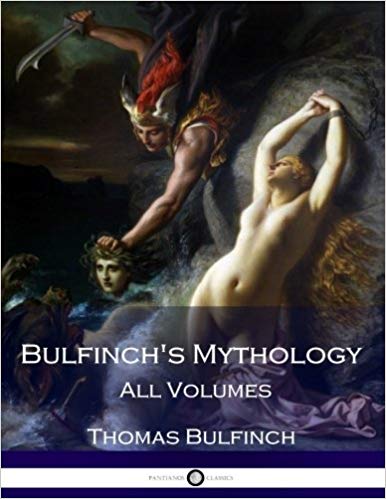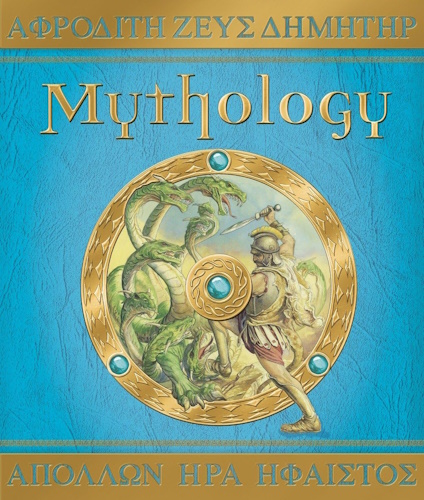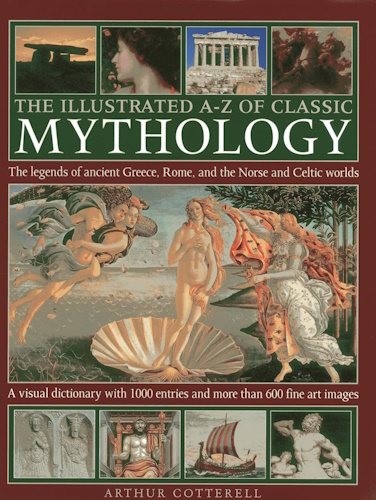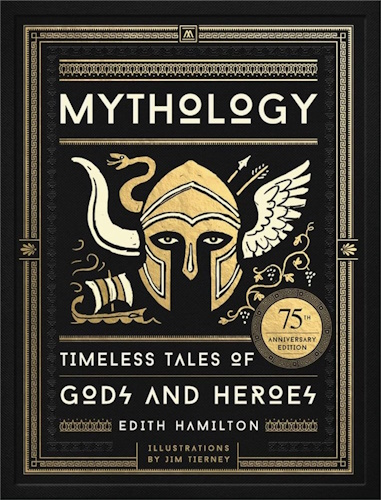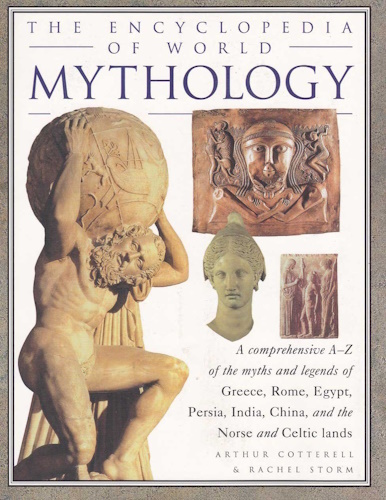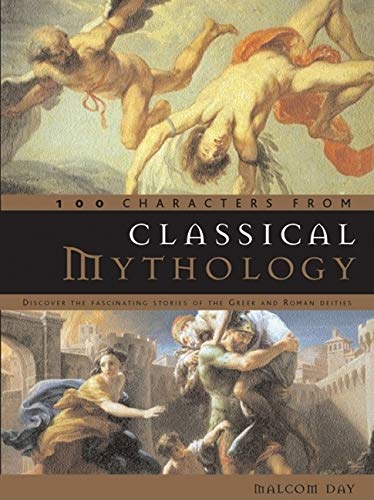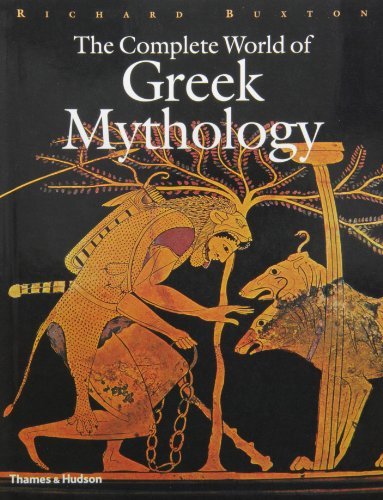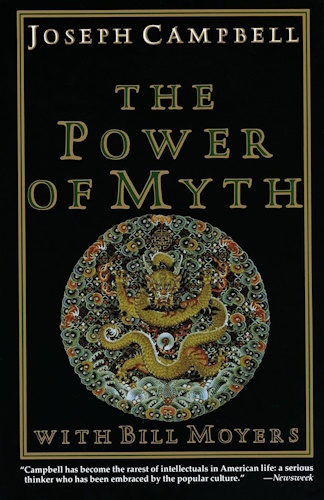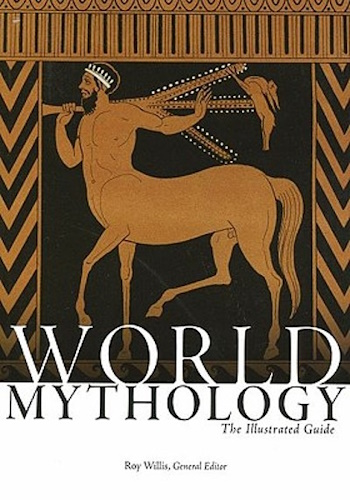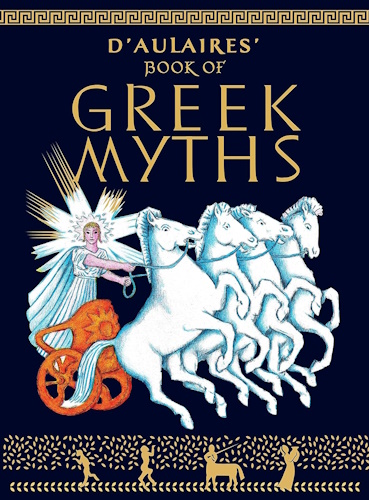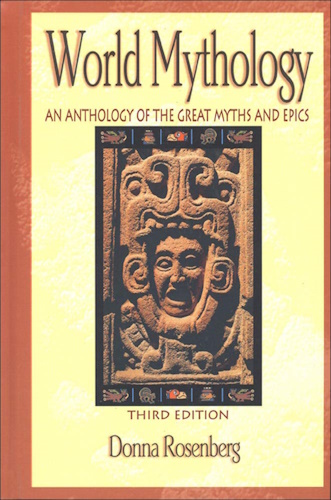
![]()
![]()
CHAPTER XXVIII.
THE FALL OF TROY- RETURN OF THE GREEKS-
AGAMEMNON, ORESTES AND ELECTRA.
THE FALL OF TROY.
THE story of the Iliad ends with the death of Hector, and it is from the Odyssey and later poems that we learn the fate of the other heroes. After the death of Hector, Troy did not immediately fall, but receiving aid from new allies still continued its resistance. One of these allies was Memnon, the AEthiopian prince, whose story we have already told. Another was Penthesilea, queen of the Amazons, who came with a band of female warriors. All the authorities attest their valour and the fearful effect of their war cry. Penthesilea slew many of the bravest warriors, but was at last slain by Achilles. But when the hero bent over his fallen foe, and contemplated her beauty, youth and valour, he bitterly regretted his victory. Thersites, an insolent brawler and demagogue, ridiculed his grief, and was in consequence slain by the hero.
Achilles by chance had seen Polyxena, daughter of King Priam, perhaps on occasion of the truce which was allowed the Trojans for the burial of Hector. He was captivated with her charms, and to win her in marriage agreed to use his influence with the Greeks to grant peace to Troy. While in the temple of Apollo, negotiating the marriage, Paris discharged at him a poisoned arrow, which, guided by Apollo, wounded Achilles in the heel, the only vulnerable part about him. For Thetis his mother had dipped him when an infant in the river Styx, which made every part of him invulnerable except the heel by which she held him.*
* The story of the invulnerability of Achilles is not found in Homer, and is inconsistent with his account. For how could Achilles require the aid of celestial armour if he were invulnerable?
The body of Achilles so treacherously slain was rescued by Ajax and Ulysses. Thetis directed the Greeks to bestow her son's armour on the hero who of all the survivors should be judged most deserving of it. Ajax and Ulysses were the only claimants; a select number of the other chiefs were appointed to award the prize. It was awarded to Ulysses, thus placing wisdom before valour, whereupon Ajax slew himself. On the spot where his blood sank into the earth a flower sprang up, called the hyacinth, bearing on its leaves the first two letters of the name of Ajax, Ai, the Greek for "woe." Thus Ajax is a claimant with the boy Hyacinthus for the honour of giving birth to this flower. There is a species of Larkspur which represents the hyacinth of the poets in preserving the memory of this event, the Delphinium Ajacis- Ajax's Larkspur.
It was now discovered that Troy could not be taken but by the aid of the arrows of Hercules. They were in possession of Philoctetes, the friend who had been with Hercules at the last and lighted his funeral pyre. Philoctetes had joined the Grecian expedition against Troy, but had accidentally wounded his foot with one of the poisoned arrows, and the smell from his wound proved so offensive that his companions carried him to the isle of Lemnos and left him there. Diomed was now sent to induce him to rejoin the army. He succeeded. Philoctetes was cured of his wound by Machaon, and Paris was the first victim of the fatal arrows. In his distress Paris bethought him of one whom in his prosperity he had forgotten. This was the nymph OEnone, whom he had married when a youth, and had abandoned for the fatal beauty Helen. OEnone remembering the wrongs she had suffered, refused to heal the wound, and Paris went back to Troy and died. OEnone quickly repented, and hastened after him with remedies, but came too late, and in her grief hung herself.*
* Tennyson has chosen OEnone as the subject of a short poem; but he has omitted the most poetical part of the story, the return of Paris wounded, her cruelty and subsequent repentance.
There was in Troy a celebrated statue of Minerva called the Palladium. It was said to have fallen from heaven, and the belief was that the city could not be taken so long as this statue remained within it. Ulysses and Diomed entered the city in disguise and succeeded in obtaining the Palladium, which they carried off to the Grecian camp.
But Troy still held out, and the Greeks began to despair of ever subduing it by force, and by advice of Ulysses resolved to resort to stratagem. They pretended to be making preparations to abandon the siege, and a portion of the ships were withdrawn and lay hid behind a neighbouring island. The Greeks then constructed an immense wooden horse, which they gave out was intended as a propitiatory offering to Minerva, but in fact was filled with armed men. The remaining Greeks then betook themselves to their ships and sailed away, as if for a final departure. The Trojans, seeing the encampment broken up and the fleet gone, concluded the enemy to have abandoned the siege. The gates were thrown open, and the whole population issued forth rejoicing at the long-prohibited liberty of passing freely over the scene of the late encampment. The great horse was the chief object of curiosity. All wondered what it could be for. Some recommended to take it into the city as a trophy; others felt afraid of it.
While they hesitate, Laocoon, the priest of Neptune, exclaims, "What madness, citizens, is this? Have you not learned enough of Grecian fraud to be on your guard against it? For my part, I fear the Greeks even when they offer gifts."* So saying he threw his lance at the horse's side. It struck, and a hollow sound reverberated like a groan. Then perhaps the people might have taken his advice and destroyed the fatal horse and all its contents; but just at that moment a group of people appeared, dragging forward one who seemed a prisoner and a Greek. Stupefied with terror, he was brought before the chiefs, who reassured him, promising that his life should be spared on condition of his returning true answers to the questions asked him. He informed them that he was a Greek, Sinon by name, and that in consequence of the malice of Ulysses he had been left behind by his countrymen at their departure. With regard to the wooden horse, he told them that it was a propitiatory offering to Minerva, and made so huge for the express purpose of preventing its being carried within the city; for Calchas the prophet had told them that if the Trojans took possession of it they would assuredly triumph over the Greeks. This language turned the tide of the people's feelings and they began to think how they might best secure the monstrous horse and the favourable auguries connected with it, when suddenly a prodigy occurred which left no room to doubt. There appeared, advancing over the sea, two immense serpents. They came upon the land, and the crowd fled in all directions. The serpents advanced directly to the spot where Laocoon stood with his two sons. They first attacked the children, winding round their bodies and breathing their pestilential breath in their faces. The father, attempting to rescue them, is next seized and involved in the serpents' coils. He struggles to tear them away, but they overpower all his efforts and strangle him and the children in their poisonous folds. This event was regarded as a clear indication of the displeasure of the gods at Laocoon's irreverent treatment of the wooden horse, which they no longer hesitated to regard as a sacred object, and prepared to introduce with due solemnity into the city. This was done with songs and triumphal acclamations, and the day closed with festivity. In the night the armed men who were enclosed in the body of the horse, being let out by the traitor Sinon, opened the gates of the city to their friends, who had returned under cover of the night. The city was set on fire; the people, overcome with feasting and sleep, put to the sword, and Troy completely subdued.
* See Proverbial Expressions, no. 6.
One of the most celebrated groups of statuary in existence is that of Laocoon and his children in the embrace of the serpents. The original is in the Vatican at Rome. The following lines are from the "Childe Harold" of Byron:
"Now turning to the Vatican go seeLaocoon's torture dignifying pain;
A father's love and mortal's agony
With an immortal's patience blending;- vain
The struggle! vain against the coiling strain
And gripe and deepening of the dragon's grasp
The old man's clinch; the long envenomed chain
Rivets the living links; the enormous asp
Enforces pang on pang and stifles gasp on gasp."
The comic poets will also occasionally borrow a classical allusion. The following is from Swift's "Description of a City Shower":
"Boxed in a chair the beau impatient sits,While spouts run clattering o'er the roof by fits,
And ever and anon with frightful din
The leather sounds; he trembles from within.
So when Troy chairmen bore the wooden steed
Pregnant with Greeks impatient to be freed,
(Those bully Greeks, who, as the moderns do,
Instead of paying chairmen, run them through);
Laocoon struck the outside with a spear,
And each imprisoned champion quaked with fear."
King Priam lived to see the downfall of his kingdom and was slain at last on the fatal night when the Greeks took the city. He had armed himself and was about to mingle with the combatants, but was prevailed on by Hecuba, his aged queen, to take refuge with herself and his daughters as a suppliant at the altar of Jupiter. While there, his youngest son Polites, pursued by Pyrrhus, the son of Achilles, rushed in wounded, and expired at the feet of his father; whereupon Priam, overcome with indignation, hurled his spear with feeble hand against Pyrrhus,* and was forthwith slain by him.
* Pyrrhus's exclamation, "Not such aid nor such defenders does the time require," has become proverbial. See Proverbial Expressions, no. 7.
Queen Hecuba and her daughter Cassandra were carried captives to Greece. Cassandra had been loved by Apollo, and he gave her the gift of prophecy; but afterwards offended with her, he rendered the gift unavailing by ordaining that her predictions should never be believed. Polyxena, another daughter, who had been loved by Achilles, was demanded by the ghost of that warrior, and was sacrificed by the Greeks upon his tomb.
MENELAUS AND HELEN.
Our readers will be anxious to know the fate of Helen, the fair but guilty occasion of so much slaughter. On the fall of Troy Menelaus recovered possession of his wife, who had not ceased to love him, though she had yielded to the might of Venus and deserted him for another. After the death of Paris she aided the Greeks secretly on several occasions, and in particular when Ulysses and Diomed entered the city in disguise to carry off the Palladium. She saw and recognized Ulysses, but kept the secret and even assisted them in obtaining the image. Thus she became reconciled to her husband, and they were among the first to leave the shores of Troy for their native land. But having incurred the displeasure of the gods they were driven by storms from shore to shore of the Mediterranean, visiting Cyprus, Phoenicia and Egypt. In Egypt they were kindly treated and presented with rich gifts, of which Helen's share was a golden spindle and a basket on wheels. The basket was to hold the wool and spools for the queen's work.
Dyer, in his poem of the "Fleece," thus alludes to this incident:
"...many yet adhereTo the ancient distaff, at the bosom fixed,
Casting the whirling spindle as they walk.
. . . . . . . .
This was of old, in no inglorious days,
The mode of spinning, when the Egyptian prince
A golden distaff gave that beauteous nymph,
Too beauteous Helen; no uncourtly gift."
Milton also alludes to a famous recipe for an invigorating draught, called Nepenthe, which the Egyptian queen gave to Helen:
"Not that Nepenthes which the wife of ThoneIn Egypt gave to Jove-born Helena,
Is of such power to stir up joy as this,
To life so friendly or so cool to thirst."
Comus.
Menelaus and Helen at length arrived in safety at Sparta, resumed their royal dignity, and lived and reigned in splendour; and when Telemachus, the son of Ulysses, in search of his father, arrived at Sparta, he found Menelaus and Helen celebrating the marriage of their daughter Hermione to Neoptolemus, son of Achilles.
AGAMEMNON, ORESTES AND ELECTRA.
Agamemnon, the general-in-chief of the Greeks, the brother of Menelaus, and who had been drawn into the quarrel to avenge his brother's wrongs, not his own, was not so fortunate in the issue. During his absence his wife Clytemnestra had been false to him, and when his return was expected, she with her paramour, AEgisthus, laid a plan for his destruction, and at the banquet given to celebrate his return, murdered him.
It was intended by the conspirators to slay his son Orestes also, a lad not yet old enough to be an object of apprehension, but from whom, if he should be suffered to grow up, there might be danger. Electra, the sister of Orestes, saved her brother's life by sending him secretly away to his uncle Strophius, King of Phocis. In the palace of Strophius Orestes grew up with the king's son Pylades, and formed with him that ardent friendship which bas become proverbial. Electra frequently reminded her brother by messengers of the duty of avenging his father's death, and when grown up he consulted the oracle of Delphi, which confirmed him in his design. He therefore repaired in disguise to Argos, pretending to be a messenger from Strophius, who had come to announce the death of Orestes, and brought the ashes of the deceased in a funeral urn. After visiting his father's tomb and. sacrificing upon it, according to the rites of the ancients he made himself known to his sister Electra, and soon after slew both AEgisthus and Clytemnestra.
This revolting act, the slaughter of a mother by her son, though alleviated by the guilt of the victim and the express command of the gods, did not fail to awaken in the breasts of the ancients the same abhorrence that it does in ours. The Eumenides, avenging deities, seized upon Orestes, and drove him frantic from land to land. Pylades accompanied him in his wanderings and watched over him. At length, in answer to a second appeal to the oracle, he was directed to go to Tauris in Scythia, and to bring thence a statue of Diana which was believed to have fallen from heaven. Accordingly Orestes and Pylades went to Tauris, where the barbarous people were accustomed to sacrifice to the goddess all strangers who fell into their hands. The two friends were seized and carried bound to the temple to be made victims. But the priestess of Diana was no other than Iphigenia, the sister of Orestes, who, our readers will remember, was snatched away by Diana at the moment when she was about to be sacrificed. Ascertaining from the prisoners who they were, Iphigenia disclosed herself to them, and the three made their escape with the statue of the goddess, and returned to Mycenae.
But Orestes was not yet relieved from the vengeance of the Erinyes. At length he took refuge with Minerva at Athens. The goddess afforded him protection, and appointed the court of Areopagus to decide his fate. The Erinyes brought forward their accusation, and Orestes made the command of the Delphic oracle his excuse. When the court voted and the voices were equally divided, Orestes was acquitted by the command of Minerva.
Byron, in "Childe Harold," Canto IV., alludes to the story of Orestes:
"O thou who never yet of human wrongLeft the unbalanced scale, great Nemesis!
Thou who didst call the Furies from the abyss,
And round Orestes bade them howl and hiss,
For that unnatural retribution,-just
Had it but been from hands less near,- in this,
Thy former realm, I call thee from the dust!"
One of the most pathetic scenes in the ancient drama is that in which Sophocles represents the meeting of Orestes and Electra, on his return from Phocis. Orestes, mistaking Electra for one of the domestics, and desirous of keeping his arrival a secret till the hour of vengeance should arrive, produces the urn in which his ashes are supposed to rest. Electra, believing him to be really dead, takes the urn and, embracing it, pours forth her grief in language full of tenderness and despair.
Milton in one of his sonnets, says:
"...The repeated airOf sad Electra's poet had the power
To save the Athenian walls from ruin bare."
This alludes to the story that when, on one occasion, the city of Athens was at the mercy of her Spartan foes, and it was proposed to destroy it, the thought was rejected upon the accidental quotation, by some one, of a chorus of Euripides.
TROY.
After hearing so much about the city of Troy and its heroes, the reader will perhaps be surprised to learn that the exact site of that famous city is still a matter of dispute. There are some vestiges of tombs on the plain which most nearly answers to the description given by Homer and the ancient geographers, but no other evidence of the former existence of a great city. Byron thus describes the present appearance of the scene:
"The winds are high, and Helle's tideRolls darkly heaving to the main;
And night's descending shadows hide
That field with blood bedewed in vain,
The desert of old Priam's pride,
The tombs, sole relics of his reign.
All- save immortal dreams that could beguile
The blind old man of Scio's rocky isle."
Bride of Abydos.
-
Urantia Book, 44:0.11 - The Celestial Artisans
Never in your long ascendancy will you lose the power to recognize your associates of former existences. Always, as you ascend inward in the scale of life, will you retain the ability to recognize and fraternize with the fellow beings of your previous and lower levels of experience. Each new translation or resurrection will add one more group of spirit beings to your vision range without in the least depriving you of the ability to recognize your friends and fellows of former estates.
-
Princess Bride 1987 Wallace Shawn (Vizzini) and Mandy Patinkin (Inigo Montoya)
Vizzini: HE DIDN'T FALL? INCONCEIVABLE.
Inigo Montoya: You keep using that word. I do not think it means what you think it means. -
Urantia Book, 117:4.14 - The Finite God
And here is mystery: The more closely man approaches God through love, the greater the reality -- actuality -- of that man. The more man withdraws from God, the more nearly he approaches nonreality -- cessation of existence. When man consecrates his will to the doing of the Father's will, when man gives God all that he has, then does God make that man more than he is.
-
Urantia Book, 167:7.4 - The Talk About Angels
"And do you not remember that I said to you once before that, if you had your spiritual eyes anointed, you would then see the heavens opened and behold the angels of God ascending and descending? It is by the ministry of the angels that one world may be kept in touch with other worlds, for have I not repeatedly told you that I have other sheep not of this fold?"
-
Urantia Book, Foreword - 0:12.12 - The Trinities
But we know that there dwells within the human mind a fragment of God, and that there sojourns with the human soul the Spirit of Truth; and we further know that these spirit forces conspire to enable material man to grasp the reality of spiritual values and to comprehend the philosophy of universe meanings. But even more certainly we know that these spirits of the Divine Presence are able to assist man in the spiritual appropriation of all truth contributory to the enhancement of the ever-progressing reality of personal religious experience—God-consciousness.
-
Urantia Book, 1:4.3 - The Mystery Of God
When you are through down here, when your course has been run in temporary form on earth, when your trial trip in the flesh is finished, when the dust that composes the mortal tabernacle "returns to the earth whence it came"; then, it is revealed, the indwelling "Spirit shall return to God who gave it." There sojourns within each moral being of this planet a fragment of God, a part and parcel of divinity. It is not yet yours by right of possession, but it is designedly intended to be one with you if you survive the mortal existence.
-
Urantia Book, 1:4.1 - The Mystery Of God
And the greatest of all the unfathomable mysteries of God is the phenomenon of the divine indwelling of mortal minds. The manner in which the Universal Father sojourns with the creatures of time is the most profound of all universe mysteries; the divine presence in the mind of man is the mystery of mysteries.
-
Urantia Book, 1:4.6 - The Mystery Of God
To every spirit being and to every mortal creature in every sphere and on every world of the universe of universes, the Universal Father reveals all of his gracious and divine self that can be discerned or comprehended by such spirit beings and by such mortal creatures. God is no respecter of persons, either spiritual or material. The divine presence which any child of the universe enjoys at any given moment is limited only by the capacity of such a creature to receive and to discern the spirit actualities of the supermaterial world.
-
Urantia Book, 11:0.1 - The Eternal Isle Of Paradise
Paradise is the eternal center of the universe of universes and the abiding place of the Universal Father, the Eternal Son, the Infinite Spirit, and their divine co-ordinates and associates. This central Isle is the most gigantic organized body of cosmic reality in all the master universe. Paradise is a material sphere as well as a spiritual abode. All of the intelligent creation of the Universal Father is domiciled on material abodes; hence must the absolute controlling center also be material, literal. And again it should be reiterated that spirit things and spiritual beings are real.
-
Urantia Book, 50:6.4 - Planetary Culture
Culture presupposes quality of mind; culture cannot be enhanced unless mind is elevated. Superior intellect will seek a noble culture and find some way to attain such a goal. Inferior minds will spurn the highest culture even when presented to them ready-made.
-
Urantia Book, 54:1.6 - True And False Liberty
True liberty is the associate of genuine self-respect; false liberty is the consort of self-admiration. True liberty is the fruit of self-control; false liberty, the assumption of self-assertion. Self-control leads to altruistic service; self-admiration tends towards the exploitation of others for the selfish aggrandizement of such a mistaken individual as is willing to sacrifice righteous attainment for the sake of possessing unjust power over his fellow beings.
-
Urantia Book, 54:1.9 - True And False Liberty
How dare the self-willed creature encroach upon the rights of his fellows in the name of personal liberty when the Supreme Rulers of the universe stand back in merciful respect for these prerogatives of will and potentials of personality! No being, in the exercise of his supposed personal liberty, has a right to deprive any other being of those privileges of existence conferred by the Creators and duly respected by all their loyal associates, subordinates, and subjects.
-
Urantia Book, 54:1.8 - True And False Liberty
There is no error greater than that species of self-deception which leads intelligent beings to crave the exercise of power over other beings for the purpose of depriving these persons of their natural liberties. The golden rule of human fairness cries out against all such fraud, unfairness, selfishness, and unrighteousness.
